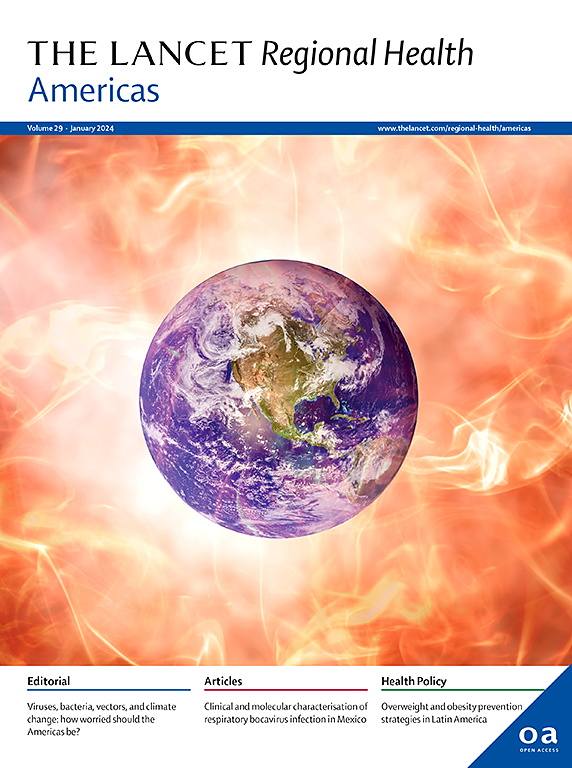拉丁美洲和加勒比地区碳青霉烯酶产生革兰氏阴性菌的监测:2015年至2020年的回顾性观察研究
IF 7
Q1 HEALTH CARE SCIENCES & SERVICES
引用次数: 0
摘要
耐多药细菌(MDR)的增加是一种公共卫生威胁,碳青霉烯类耐药性加剧了这一挑战。本研究调查了整个拉丁美洲和加勒比地区(LAC)产碳青霉烯酶细菌(CPB)。方法2015 - 2020年在12个LAC国家进行回顾性观察性研究。采用聚合酶链反应(PCR)对58,909株分离菌株进行了碳青霉烯酶检测,检测了肠杆菌、铜绿假单胞菌和鲍曼不动杆菌复体(ABC)的关键酶。共发现47,804/58,909(81.14%)种碳青霉烯酶,其中巴西占73%。以耐碳青霉烯类肠杆菌- cre (65.33%;31,230/47,804),其次是碳青霉烯耐药ABC-CRAB (22.05%;耐碳青霉烯P. aeruginosa-CRPA (6050/47,804;12.66%)。在CRE中,blaKPC是检出最多的基因(78.67%);24,569/31,230),肺炎克雷伯菌是最常见的相关菌(75.9%)。观察到相关的blaNDM上升趋势。CRPA表现出不同的特征,以blaVIM(47.64%)最为常见。在螃蟹中,88.80%(9361/ 10542)的分离株中检出blaOXA-23。在2.60%(1190/47,804)的分离株中检测到碳青霉烯酶共产,以CRPA blaIMP + blaVIM最常见。本研究强调了CPB在LAC的高患病率,在blaKPC中呈稳定趋势,而在blaNDM中呈上升趋势。这些发现强调迫切需要加强监测和公共卫生干预,以对抗该地区碳青霉烯酶介导的耐药性。本文章由计算机程序翻译,如有差异,请以英文原文为准。
Carbapenemases producing gram-negative bacteria surveillance in Latin America and the caribbean: a retrospective observational study from 2015 to 2020
Background
The rise of multidrug-resistant (MDR) bacteria represents a public health threat, with carbapenem resistance exacerbating this challenge. This study investigates carbapenemase-producing bacteria (CPB) across the Latin America and the Caribbean (LAC) region.
Methods
A retrospective observational study was conducted across 12 LAC countries from 2015 to 2020. A total of 58,909 isolates were analyzed utilizing polymerase chain reaction (PCR) to detect key carbapenemases in Enterobacterales, Pseudomonas aeruginosa, and Acinetobacter baumannii complex (ABC).
Findings
47,804/58,909 (81.14%) carbapenemases were identified, with Brazil accounting for 73% of these. The majority were reported in carbapenem-resistant Enterobacterales–CRE (65.33%; 31,230/47,804), followed by carbapenem-resistant ABC-CRAB (22.05%; 10,542/47,804), and carbapenem-resistant P. aeruginosa–CRPA (6050/47,804; 12.66%). Among CRE, blaKPC was the most detected gene (78.67%; 24,569/31,230), with Klebsiella pneumoniae being the most commonly associated species (75.9%). A relevant upward trend in blaNDM was observed. CRPA exhibited diverse profiles, with blaVIM (47.64%) being the most common. In CRAB, blaOXA-23 was found in 88.80% (9361/10,542) of isolates. Carbapenemase co-production was detected in 2.60% (1190/47,804) of isolates, with CRPA blaIMP + blaVIM being the most frequent.
Interpretation
This study highlights a high prevalence of CPB in LAC, with a stable trend in blaKPC but a rising trend in blaNDM. These findings underscore the urgent need for strengthened surveillance and public health interventions to combat carbapenemase-mediated resistance in the region.
Funding
None.
求助全文
通过发布文献求助,成功后即可免费获取论文全文。
去求助
来源期刊

Lancet Regional Health-Americas
Multiple-
CiteScore
8.00
自引率
0.00%
发文量
0
期刊介绍:
The Lancet Regional Health – Americas, an open-access journal, contributes to The Lancet's global initiative by focusing on health-care quality and access in the Americas. It aims to advance clinical practice and health policy in the region, promoting better health outcomes. The journal publishes high-quality original research advocating change or shedding light on clinical practice and health policy. It welcomes submissions on various regional health topics, including infectious diseases, non-communicable diseases, child and adolescent health, maternal and reproductive health, emergency care, health policy, and health equity.
 求助内容:
求助内容: 应助结果提醒方式:
应助结果提醒方式:


